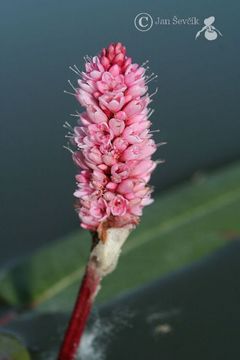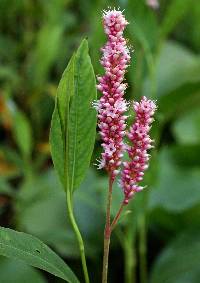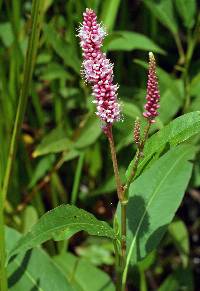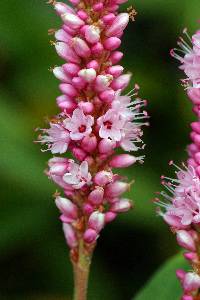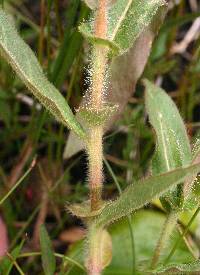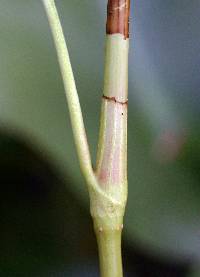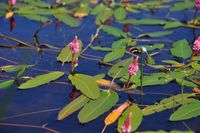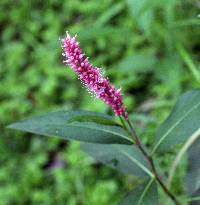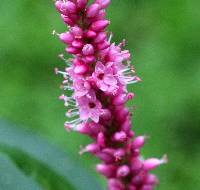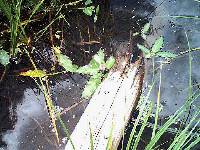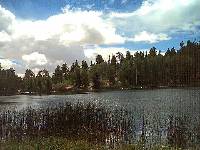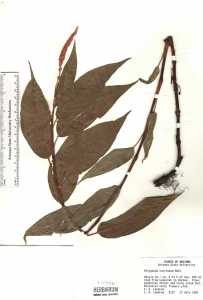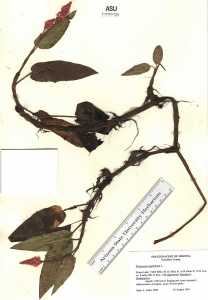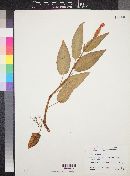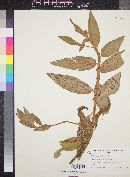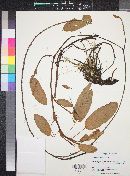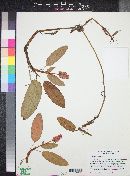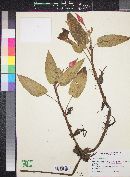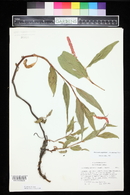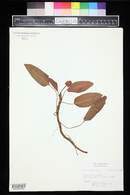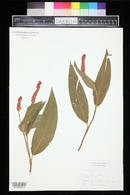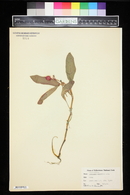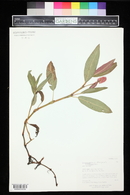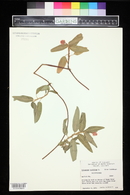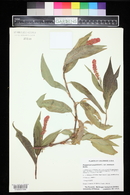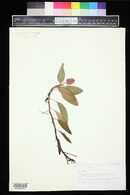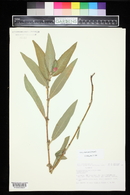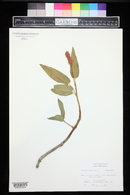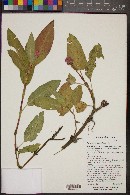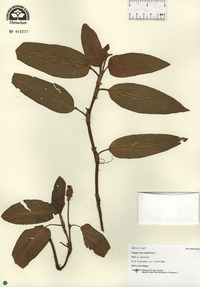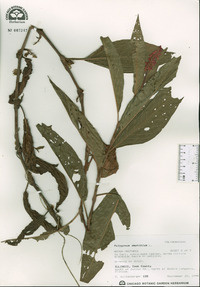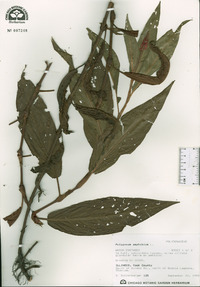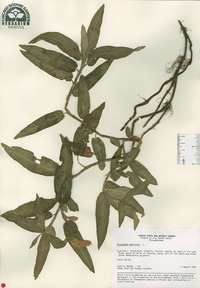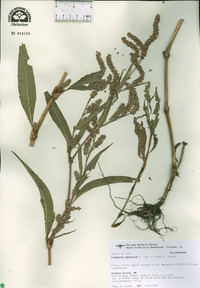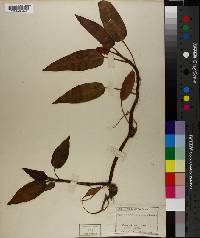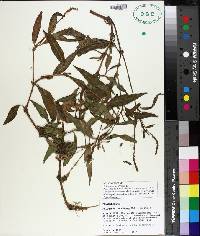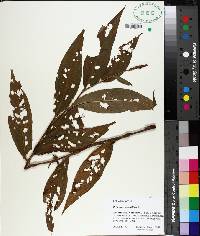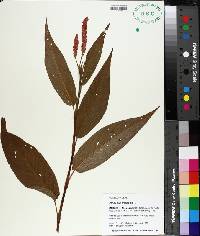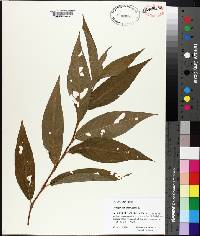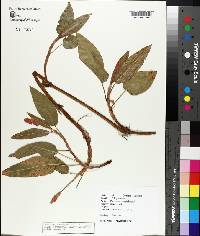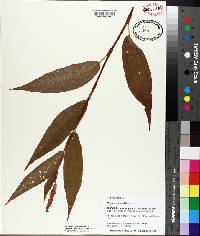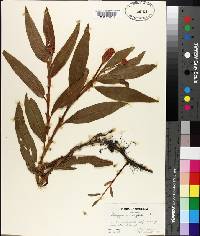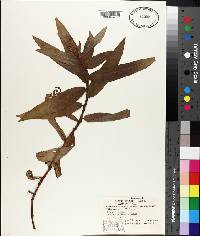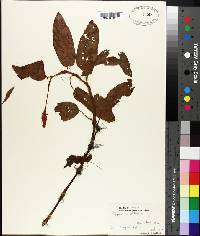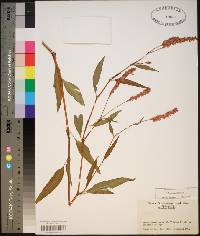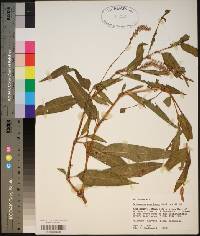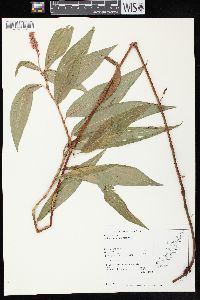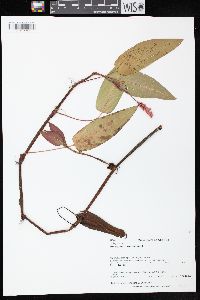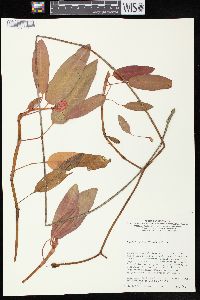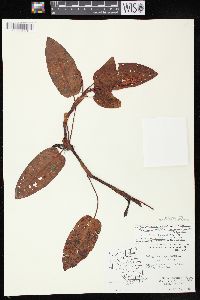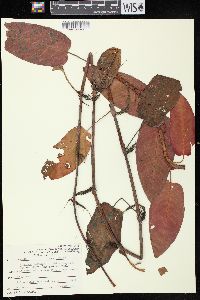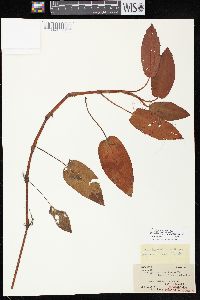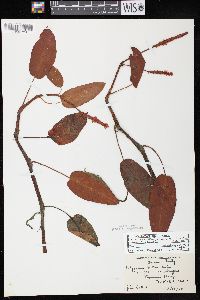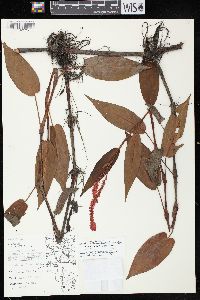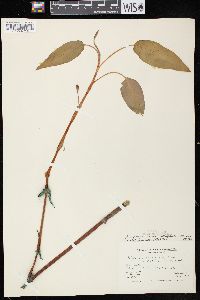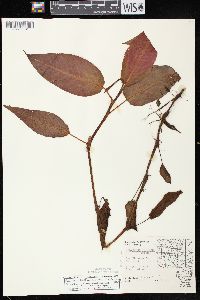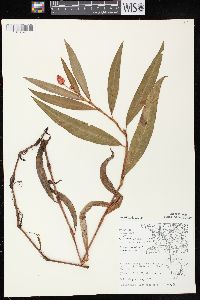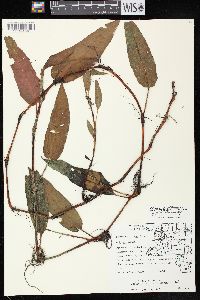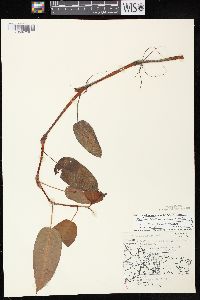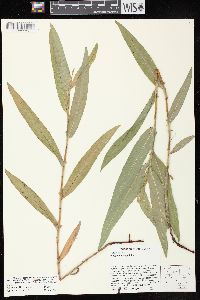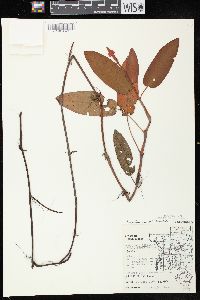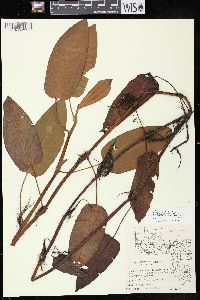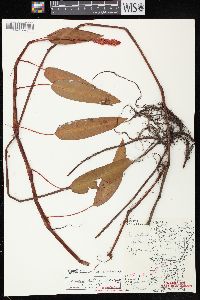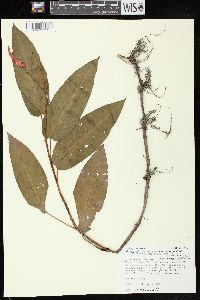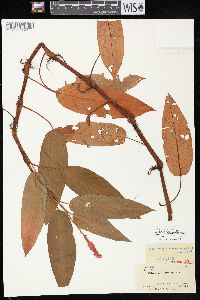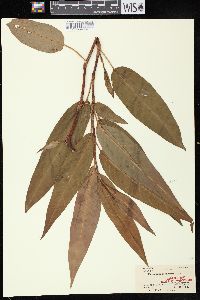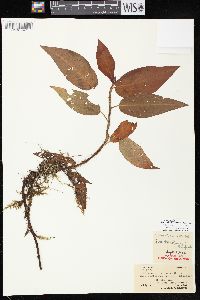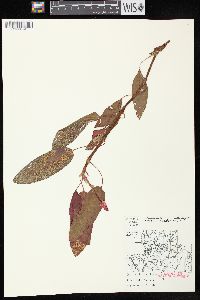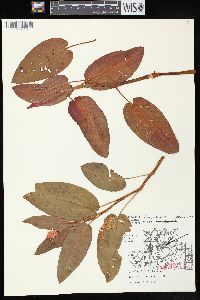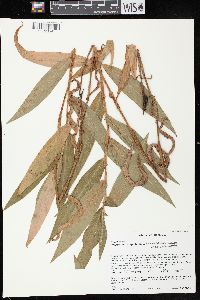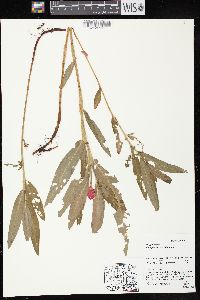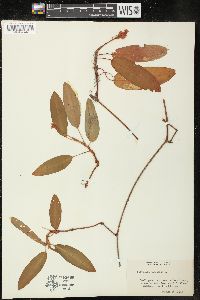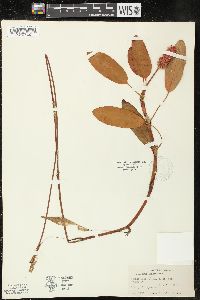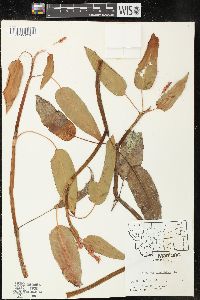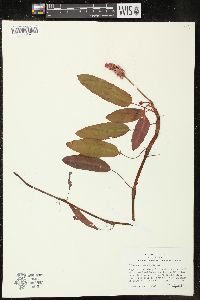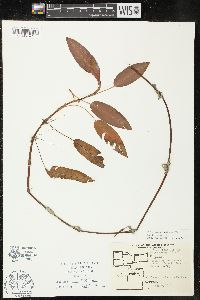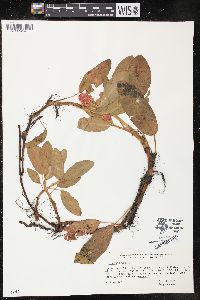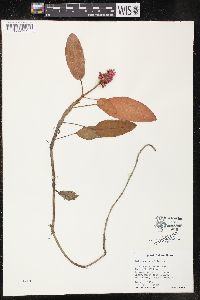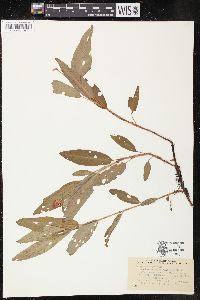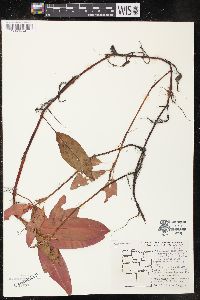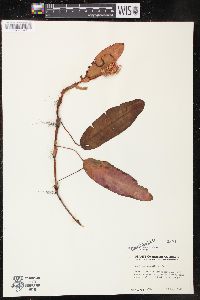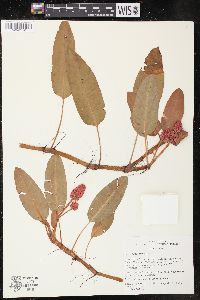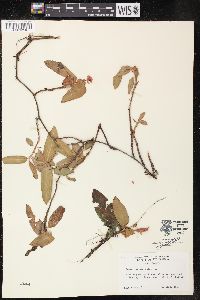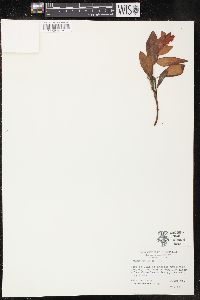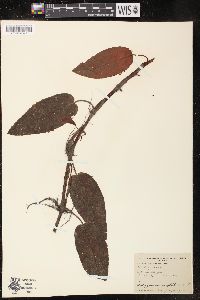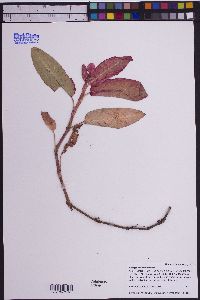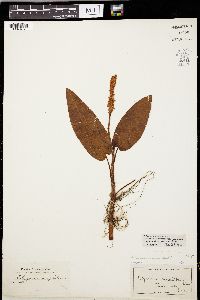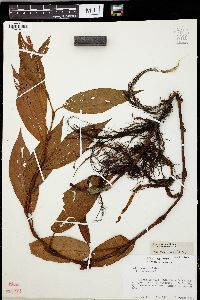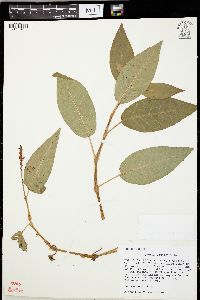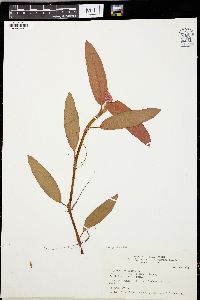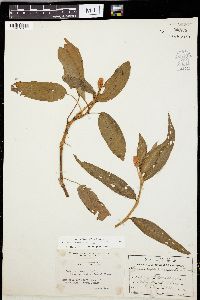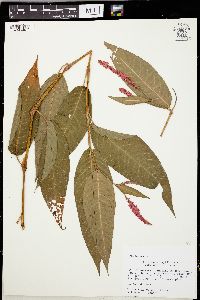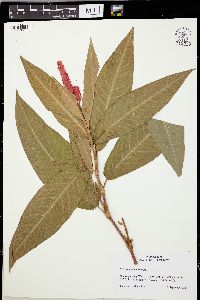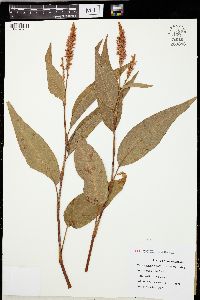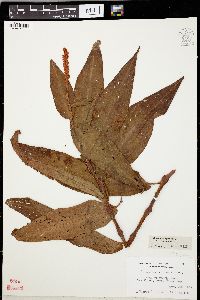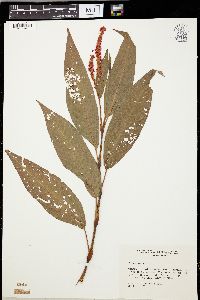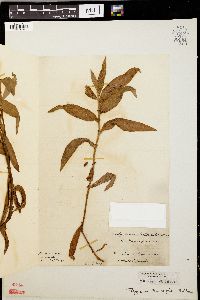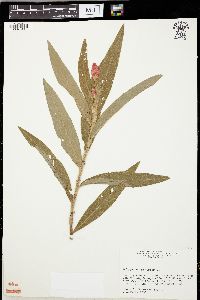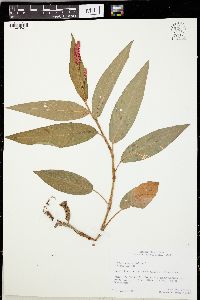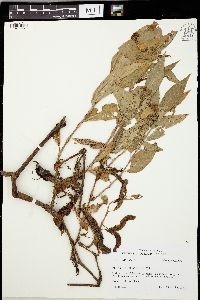
|
|
|
|
Family: Polygonaceae
Water Smartweed, more...water knotweed, water smartweed, longroot smartweed
[Persicaria amphibia var. emersa (Michx.) Hickman, morePersicaria amphibia var. stipulacea (Coleman) Hara, Persicaria coccinea (Muhl. ex Willd.) Greene, Persicaria mesochora Greene, Persicaria muehlenbergii (S. Wats.) Small, Persicaria muhlenbergii , Persicaria nebraskensis Greene, Polygonum amphibium L., Polygonum amphibium subsp. laevimarginatum Hultén, Polygonum amphibium var. amphibium , Polygonum amphibium var. aquaticum Hook., Polygonum amphibium var. coccineum (Muhl. ex Willd.) Farw., Polygonum amphibium var. emersum Michx., Polygonum amphibium var. fluitans Bruyn, Polygonum amphibium var. hartwrightii (Gray) Bissell, Polygonum amphibium var. natans Michx., Polygonum amphibium var. stipulaceum Coleman, Polygonum amphibium var. terrestre Leyss., Polygonum coccineum Muhl. ex Willd., Polygonum coccineum f. terrestre (Willd.) Stanford, Polygonum coccineum var. coccineum , Polygonum coccineum var. pratincola (Greene) Stanford, Polygonum coccineum var. rigidulum (Sheldon) Stanford, Polygonum coccineum var. terrestre Willd., Polygonum emersum (Michx.) Britton, Polygonum fluitans Eat., Polygonum hartwrightii Gray, Polygonum inundatum Raf., Polygonum muehlenbergii S. Wats., Polygonum muehlenbergii var. terrestre (Willd.) Trel., Polygonum muhlenbergii var. terrestre (Willd.) Trel., Polygonum natans Eat.] |
Plants perennial, 2-12 dm in terrestrial plants, to 30 dm in some aquatic plants; roots also sometimes arising from proximal nodes; rhizomes or stolons usually present. Stems prostrate to ascending or erect, simple or branched, ribbed, glabrous or strigose to hirsute. Leaves: ocrea tan to dark brown, cylindric or flared distally, 5-50 mm, chartaceous or, sometimes, foliaceous distally, base inflated, margins truncate to oblique, glabrous or ciliate with hairs 0.5-4.5 mm, surface glabrous or appressed-pubescent to hirsute, not glandular-punctate; petiole 0.1-3(-7) cm, glabrous or appressed-pubescent to hirsute, leaves sometimes sessile; blade without dark triangular or lunate blotch adaxially, ovate-lanceolate to elliptic or oblong-lanceolate, 2-15(-23) × 1-6(-8) cm, base usually tapered to acute or rounded, rarely cordate, margins antrorsely scabrous, apex acute to acuminate, faces glabrous or sparingly strigose, midveins glabrous or strigose, not glandular-punctate. Inflorescences terminal, ascending to erect, uninterrupted or interrupted proximally, 10-150 × 8-20 mm; peduncle 10-50 mm, glabrous or strigose to hirsute, often stipitate-glandular; ocreolae overlapping except sometimes proximal ones, margins ciliate with bristles to 1 mm. Pedicels ascending, 0.5-1.5 mm. Flowers bisexual or functionally unisexual, some plants having only staminate flowers, others with only pistillate flowers, 1-3(-4) per ocreate fascicle, heterostylous; perianth roseate to red, glabrous, not glandular-punctate, slightly accrescent; tepals 5, connate ca. 3 their lengths, obovate to elliptic, 4-6 mm, veins prominent, not anchor-shaped, margins entire, apex rounded to acute; stamens 5, included or exserted; anthers pink or red, elliptic; styles 2, included or exserted, connate 2- 3 their length. Achenes included, dark brown, biconvex, (2-)2.2-3 × (1.5-)1.8-2.6 mm, shiny or dull, smooth or minutely granular. 2n = 66, 132. Flowering Jun-Sep. Shallow water, shorelines of ponds and lakes, banks of rivers and streams, moist prairies and meadows; 0-3000 m; St. Pierre and Miquelon; Alta., B.C., Man., N.B., Nfld. and Labr., N.W.T., N.S., Ont. , P.E.I., Que., Sask., Yukon; Alaska, Ariz., Ark., Calif., Colo., Conn., Del., D.C., Idaho, Ill., Ind., Iowa, Kans., Ky., La., Maine, Md., Mass., Mich., Minn., Miss., Mo., Mont., Nebr., Nev., N.H., N.J., N.Mex., N.Y., N.C., N.Dak., Ohio, Okla., Oreg., Pa., R.I., S.C., S.Dak., Tenn., Tex., Utah, Vt., Va., Wash., W.Va., Wis., Wyo.; Mexico; South America; Eurasia; Africa. Persicaria amphibia is widespread in the Northern Hemisphere and naturalized in Mexico, South America, and southern Africa. It is highly polymorphic and the most hydrophytic of the native North American smartweeds (R. S. Mitchell 1976). In recent decades, botanists have tended to follow Mitchell (1968) in recognizing two endemic, intergrading North American varieties. Studies by G. Turesson (1961) and Mitchell (1968, 1976) have shown that phenotypic extremes in the species are part of a cline of nearly continuous morphological variation that is strongly correlated with submergence, but also with some genetic integrity. Formal recognition of varieties is even less tenable when Eurasian elements also are considered. Aquatic-adapted plants, which bloom in water or are sometimes stranded on land, have been called var. stipulacea (although that epithet may not be the oldest one available for the taxon). They produce ovoid-conic to short-cylindric inflorescences 10-40(-60) mm, prostrate aerial stems, and leaf blades that are glabrous with acute to rounded apices. Terrestrial forms of this ecotype usually are spreading-pubescent and often bear ocreae that are foliaceous, green, and flared distally, characters found only in North American plants (R. S. Mitchell 1968). Terrestrial-adapted plants, referred to var. emersa, bloom on moist soil and produce short- to elongate-cylindric inflorescences 40-110(-150) mm, spreading or erect aerial stems, and leaf blades that are appressed-pubescent with acute to acuminate apices. They produce ocreae that are entirely chartaceous and not flared distally. Emergent and terrestrial plants of this ecotype exhibit less phenotypic plasticity and a lower frequency of heterostyly than do plants of the aquatic ecotype (R. S. Mitchell 1968). R. S. Mitchell and J. K. Dean (1978) and H. R. Hinds (2000) recognized var. amphibia, the Eurasian element, as introduced in New York and New Brunswick, respectively. These plants are morphologically intermediate between the North American ecotypes and often indistinguishable from North American plants (Mitchell and Dean). The Meskwaki and Ojibwa used leaves, stems, and roots as a drug to treat a variety of maladies, the Potawatomi used roots to treat unspecified ailments, and the Lakota and Sioux used plants for food (D. E. Moerman 1998).
Duration: Perennial Lifeform: Forb/Herb General: Perennial, 20-120 cm long in terrestrial plants, up to 300 cm in some aquatic plants; stems prostrate, ascending, or erect, simple to branched, glabrous or appressed-pubescent to hirsute; rhizomes and stolons usually present. Leaves: Cauline, alternate, ovate-lanceolate, elliptic, or oblong-lanceolate, mostly 2-15 cm long, 1-6 cm wide, glabrous or appressed-pubescent to hirsute, dark triangular or crescent-shaped blotch absent, margins entire; ocrea cylindric or flared towards the apex, 5-50 mm long, papery, tan to dark brown, glabrous or appressed-pubescent to hirsute; petiole mostly 0.l-3 cm long. Flowers: Inflorescence panicle-like to raceme-like, with 2-6 flowers per fascicle; peduncle 1-17 cm long; pedicels spreading to reflexed, 3-5 mm long; perianth 1-2.5 mm long, red to greenish, the outer 2 tepals spreading in fruit, the inner 2 remaining appressed; stigmas conspicuously exserted at time of flowering; flowers July-September. Fruits: Achene, biconvex, 2-3 mm long, dark brown, shiny to dull. Ecology: Ponds, marshes, tanks, and other wet habitats, sometimes in terrestrial habitats; 1500-2700 m (5000-9000 ft); Apache, Cochise, Coconino, Gila, Graham, Navajo, Pima, Pinal, Santa Cruz, and Yavapai counties; widely distributed throughout North America and M Notes: na Synonyms: Polygonum amphibium var. emersum, Persicaria amphibia var. emersa, Persicaria coccinea, Persicaria muehlenbergii, Polygonum amphibium var. coccineum, Polygonum coccineum, Polygonum coccineum var. pratincola, Polygonum coccineum var. terrestre, Polygonum m Editor: Springer et al. 2008 Rhizomatous, functionally dioecious perennial, aquatic or amphibious or terrestrial, the terrestrial forms erect or ascending, to 1(-2) m, with hairy, typically lance-acuminate lvs, the more strongly aquatic forms with floating branches (and often stolons) and lvs, the lvs then glabrous, typically elliptic and obtuse or rounded; ocreae with or without a bristly fringe, in aerial forms often with a flared collar; racemes stout, dense, mostly 2-15 נ1-2 cm, usually borne singly or in pairs at the tips of major branches; tep 5, pink or red, bluntly rounded above, united below, 4-5 mm at anthesis, to 7 mm in fr, becoming veiny and enclosing the achene, this dark, shiny, doubly convex, 2.5-3 mm; 2n=66, 96, 98. Widespread in the N. Hemisphere, and in S. Afr. Our members of the species may be organized into 2 copiously intergrading ecotypic vars. The aquatic-adapted extreme, var. stipulaceum N. Coleman, flowers only when in water; its infls are to 4 cm, and the lvs are typically glabrous, floating, and elliptic. (P. natans; P. hartwrightii) The terrestrial-adapted extreme, var. emersum Michx., grows on land or is strongly emergent from shallow water, and does not produce floating leaves or shoots; its infls are 4-15 cm, the lvs are hairy and acuminate, and the peduncles are glandular-hairy. (P. coccineum; P. muhlenbergii). Var. amphibium is strictly Eurasian. (Persicaria a.) Gleason, Henry A. & Cronquist, Arthur J. 1991. Manual of vascular plants of northeastern United States and adjacent Canada. lxxv + 910 pp. ©The New York Botanical Garden. All rights reserved. Used by permission. From Flora of Indiana (1940) by Charles C. Deam [Deam delineates two species in this complex: P. amphibia sensu stricto has glabrous peduncles and are aquatic plants with floating leaves bearing obtuse or subacute apices. His second species, P. coccinea, has pubescent/glandular peduncles, a semi-aquatic to terrestrial habit, and very acute to acuminate leaf apices. Regarding P. amphibia s.s. Deam observes the following:] All of our reports for Persicaria amphibia (L.) S. F. Gray, Persicaria fluitans (Eaton) Greene, Polygonum amphibium L., and Polygonum amphibium var. aquaticum Willd. I am referring to this species. The nomenclature of this and the next species [Polygonum coccineum] has long been so involved that their distribution in the state can not be determined from the published records. It is, no doubt, restricted to the lake area of the state. [Regarding P. coccinea Deam observes that] this species is an aggregate to which, since I am not able to separate it satisfactorily into forms and varieties, I am referring all reports from Indiana of the following: Persicaria coccinea (Muhl.) Greene, Persicaria coccinea var. asprella Greene, Persicaria coccinea var. tanaophylla Nieuwl., Persicaria emersa (Michx.) Small, Persicaria grandifolia Greene, Persicaria lonchophylla Greene, Persicaria mesochora var. arenicola Nieuwl., Persicaria Muhlenbergii (Wats.) Small, Persicaria pratincola Greene, Persicaria tanaophylla Nieuwl., Polygonum coccineum var. pratincola (Greene) Stanford, Polygonum emersum (Michx.) Britt., Persicaria mesochora Greene, and Polygonum Muhlenbergii (Meisn.) Wats. The named variations of this species and the segregates from it are based mostly upon leaf characters, such as the general shape and base of the blades. Using these characters, I have one specimen which belongs to three species. I have a series of specimens of this species all from the same rootstock which might be referred to different species. The species is perennial. One year it may be in deep water, the next year it may be in shallow water or for part of the year it may be on dry ground. The species has great ability to persist even when its habitat is drained, and it often advances from ditches along railroads up the banks of the fills to high ground where it seems to thrive better than in a wet habitat. The habitat and the vigor of the plants greatly change the character of the leaves. Therefore, I believe it is useless to try to name all of the many forms. …… Indiana Coefficient of Conservatism: C = 4 Wetland Indicator Status: OBL |
|
|
|

